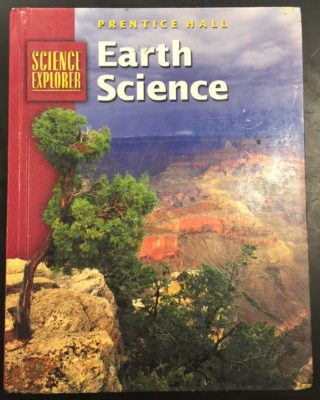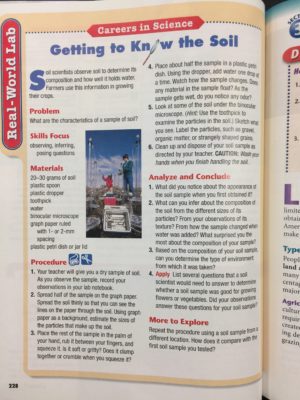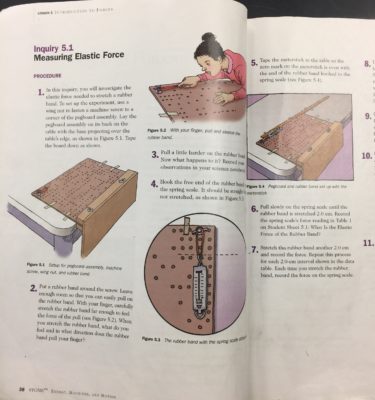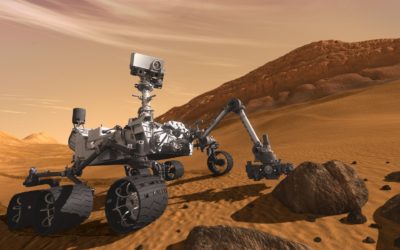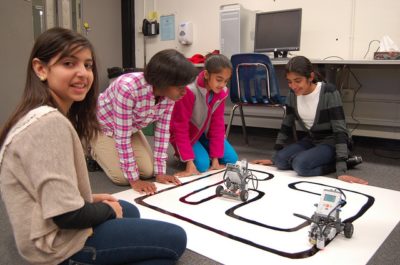Originally published on the CORELaborate blog!
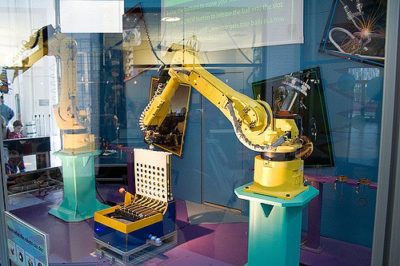 Earlier this school year I volunteered to be part of our district’s Science Subject Area Committee (SAC) to come up with recommendations to the school board for a grades 6 through 12 Science adoption of new NGSS curriculum. The team was made up of two high school Science teachers, a grades 4 through 12 alternative education Science teacher and one middle school Science teacher (me). At the middle school we’ve been spending time the last couple of years aligning our existing curriculum, much of which is teacher-created, to the NGSS so finally getting a turn at not only new curriculum but curriculum for the entire year AND NGSS aligned got us middle school Science Teachers very excited.
Earlier this school year I volunteered to be part of our district’s Science Subject Area Committee (SAC) to come up with recommendations to the school board for a grades 6 through 12 Science adoption of new NGSS curriculum. The team was made up of two high school Science teachers, a grades 4 through 12 alternative education Science teacher and one middle school Science teacher (me). At the middle school we’ve been spending time the last couple of years aligning our existing curriculum, much of which is teacher-created, to the NGSS so finally getting a turn at not only new curriculum but curriculum for the entire year AND NGSS aligned got us middle school Science Teachers very excited.
One of the topics that came up while previewing what was out there in terms of NGSS-aligned curriculum was the kit versus textbook concept. The NGSS is aiming to change the way we teach Science to students and, in my opinion, using textbooks to teach science lends itself quite easily to teach traditionally.
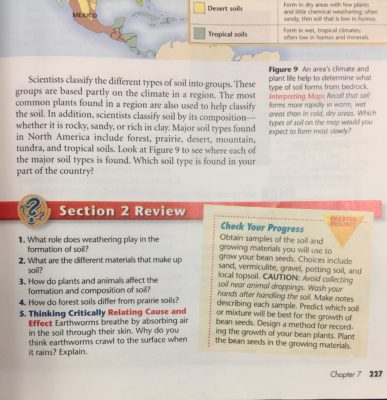
Each chapter of this textbook is divided into three or four sections and each sections ends with review questions such as these.
Textbooks usually, as shown in the Copyright 2001 textbook above, start with an activity, have content for students to learn by reading a chapter or section, answer questions to review their learning, then conduct a lab to try out their new learning. The NGSS recommends starting with what they call a phenomena then have kids interact with materials to try and make sense of the phenomena. Once our students are hooked, the Science concepts will be easier to learn. They will be more motivated to learn Science because they are trying to unravel the phenomena (we are curious creatures after all).
Kits, on the other hand, typically come in containers with all the materials needed for all the labs (See photos below). The textbooks or student workbooks come separately and are usually thinner than traditional textbooks. Sometimes the books are soft cover books instead of hardcover.
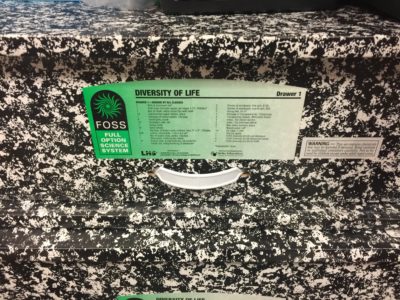
Here’s what the Foss Diversity of Life kit looks like. This is one of the drawer-type boxes that come with the set.
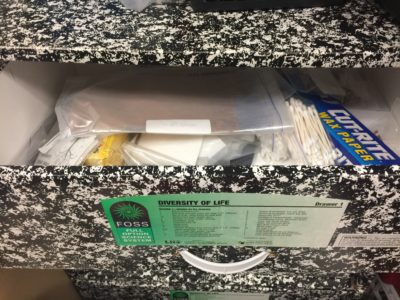
Here’s the drawer opened to reveal the contents (this one has been used for a few years so is not as neatly packed or complete as it should be). 🙂
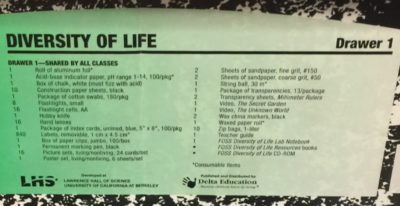
This is an example of what materials are included in the aforementioned drawer or box. Each box comes with different materials for the different labs in the unit.
The Kits I have used, Foss and STC/MS, start with an activity much like the textbooks do, what I gather is the phenomena, then goes right into a lab before asking reflection questions based on the lab. Slightly different progression. The part I appreciate as a Science teacher is that we start with a lab, then make sense of the Science (the reading comes after students have engaged with the lab). I have done more labs teaching from kits than using textbooks only. See images below of an STC/MS kit book.
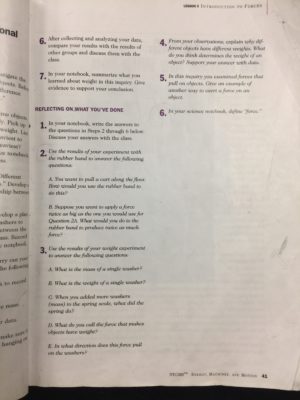
The questions in a kit-based textbook are typically after the lab asking students to reflect on what they learned and the data they actually collected.
Another draw of kit-based Science curriculum, especially for elementary teachers and even middle school teachers, is that all the lab materials are in the kit and organized for immediate use! The teacher does not have to order all the materials separately because they come in the kit! The labs can be setup quickly freeing the teacher to focus on helping students learn. Plus, the teacher does not have to worry about pacing and developmental sequencing of activities because the kit makers took that into account when putting the labs together. I hear from many teachers who use textbooks that they have to come up with their own labs because they are typically not satisfied with the labs presented in textbooks.
So in my search for an NGSS kit-based curriculum, I went to the kit providers I’ve used recently. I started by looking at the STC/MS from Carolina biological. At the time I checked there was no mention of NGSS alignment (a recent search shows that maybe that has changed and they are now offering an NGSS curriculum!). I then checked Foss and they only had some of their middle school kits aligned with more to come in 2018 (we really want to adopt and be ready to go in the fall so that didn’t work). I then heard of IQWST from Activate Learning and their kit-based curriculum for middle school was fully NGSS integrated. I recently spoke with a gentleman who works for a company that was hired by Activate Learning to evaluate their IQWST curriculum development and he assured me that they built their curriculum using the NGS Standards!
So I built my middle school curriculum recommendation around the IQWST curriculum for grades 6, 7 and 8. I thought the work ahead was going to be smooth sailing working with just IQWST until I was able to attend this year’s NCCE conference in Portland. I was drawn to a few sessions and workshops about robotics. Science is cool and awesome but the idea of STEM and Robotics, in particular, was appealing to me because it’s something I’ve not been able to provide my students. And doing an Hour of Code every year for the past few years has shown me how engaging beginning coding and coding-type games are for kids. So I went to some robotics sessions to see what I could learn and boy did I come away inspired!
By pure chance I saw a pattern emerge from the seemingly disconnected sessions and workshops I attended, a pattern of engaging students in STEM AND NGSS through robotics and coding! Specifically, using Lego Mindstorms EV3 robot kits. One session I attended introduced me to the STEM Robotics 101 free curriculum for the EV3. After that session, I attended a workshop where I got to play with an EV3 and program it to do stuff and I was hooked! Lego building also naturally incorporates engineering, an integral component of STEM AND NGSS! And come to find out, the STEM Robotics 101 free curriculum hit the physical science NGSS standards that I am already doing with my 6th graders in addition to the engineering standards! It all just fit too well.
So tomorrow I present my new plan for a 6th grade STEM curriculum based on the STEM Robotics 101 curriculum targeting the same NGSS physical science standards we are supposed to help students learn, and an IQWST adoption for grades 7 and 8. I’ll share more and let you all know how it went in my next post (I don’t want to share too much before our school board gets to hear what I’m planning)!

